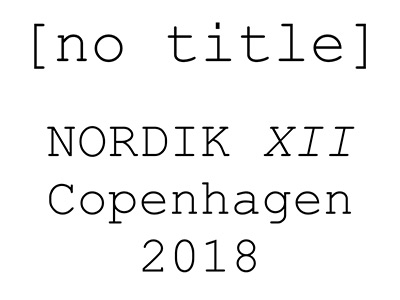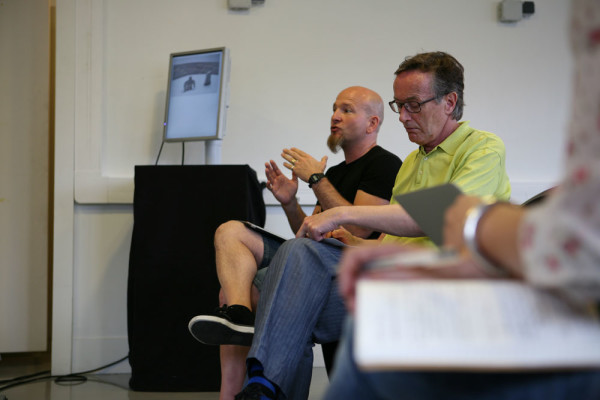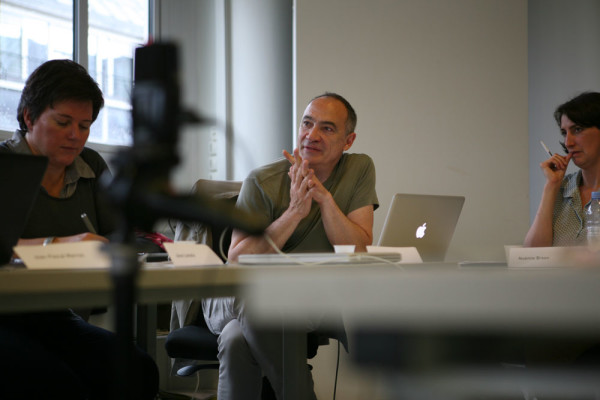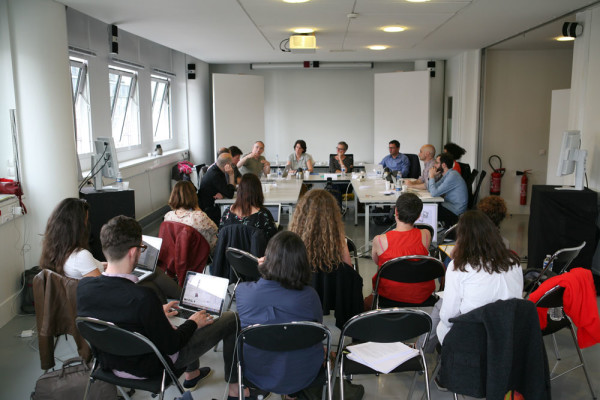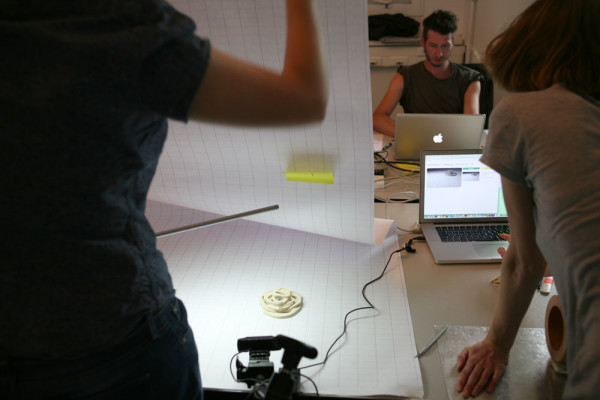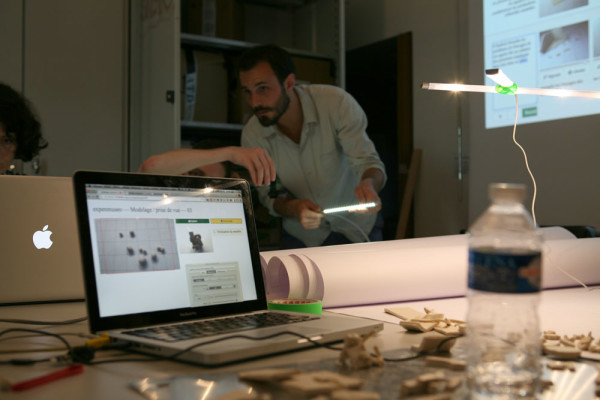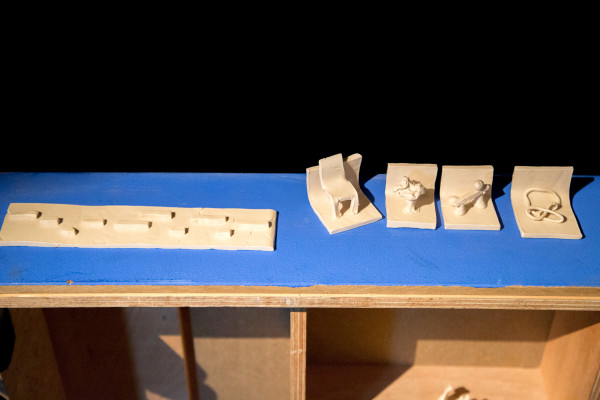English translation of the publication: Thierry Fournier, J. Emil Sennewald and Pauline Gourlet, Recherche par l’exposition et condition post-numérique, Proteus Journal 10 | 2016, (Le Commissariat comme forme de recherche / Curating as a form of research) [online].
Research through exhibition and post-digital condition
Thierry Fournier, J. Emil Sennewald and Pauline Gourlet
(Displays research group / EnsadLab Research Laboratory, EnsAD, Paris, France)
Thierry Fournier is an artist, curator and researcher; he heads the Displays/EnsadLab research group (Ensad research laboratory, PSL). J. Emil Sennewald is an art critic, journalist, and lecturer at the École supérieure d’art Clermont-Metropole; he co-coordinates the Displays/EnsadLab research group. Pauline Gourlet is a designer and PhD student at University of Paris 8, Displays/EnsadLab, Labex Arts-H2H. www.displays.ensadlab.fr
Abstract
If exhibition as practice is taken as a form of research, it has to be approached today regarding its post-digital condition, which is characterized by the overall presence of digitality and networks. In the following paper, we develop the effects of this condition. After showing how it has shifted exhibition-curating to curating in a broader sense and especially as curation, we are going to develop how it transformed interactions between actors, objects and spaces and furthermore changed methods and practices of exhibition. Rather than questioning curating, we understand exhibition as a “cognitive practice” triggering thinking and not just representing its results. How can “research through exhibition” activate an emancipation-process in regard to today’s economies of attention and digital industries? Our answer: By placing its constituting elements and agents in a transductive situation crystalizing the intra-active relations between subjects, contexts, objects, spaces, machines and apparatuses.
Keywords
Curating, curatorship, post-digital, emancipation, transduction
“And how could it be otherwise, since we wouldn’t have been read this text, in the best of cases, only after having visited the exhibition?” Hubert Damisch[1]
Under the influence of contemporary cultural industries, as institutions, art dealers and politicians seek to maximize the symbolic profit of the arts, as digital technologies are becoming the daily fare of museum education programs and of exhibition design[2], and as the spaces of decision-making authority are being renegotiated between cultural and scientific players under the label “research”[3], it becomes essential to raise the question of conditions. Research, culture, and exhibition conditions that are largely remodeled by the omnipresence of digital technologies and of the internet, which have not yet come to an end, but, as Hito Steyerl so aptly put it, “is all over”[4]. After the utopias, the promises and the ideologies of “new technologies”[5], after the ubiquity of digital technologies[6], after the experience economy and the attention economy[7], and finally, after the cultural sphere was fundamentally transformed to become a process that watches itself as it acts[8], how can the way of thinking exhibitions evolve and how can curating constitute a type of research?
In order to limit this article’s scope of analysis, we have concentrated here on art exhibitions. We will try to define what it is that characterizes a post-digital condition, and what this condition has changed so far in exhibition processes. We will then discuss what research through the exhibition would be, and attempt to outline the stakes of critical thinking through the exhibition and how the latter would be redefined by a post digital condition. We will subsequently be challenging possible re-appropriations of these apparatuses: how can artists and curators offer an emancipating experience?
The post-digital condition, curating and curation
We suppose, first of all, that the question of exhibition curation as a form of research must be reconsidered in relation to its post-digital condition[9]. This term refers to the situation in which digital technologies and the network have become widespread and constitute the framework for nearly all human actions. The prefix “post” does not qualify a notion of time (what would happen after the advent of digital technologies), but rather a condition – what happens when digital technologies are present everywhere[10].
On this particular point, recent history of the relation between art and digital technology bears witness to a significant evolution that qualifies and historically sets the term post-digital[11]. From the 60s to the 00s, one could witness the development of different approaches that treat digital technology in art mainly as a medium, and share the common objective of extending the expressive and experiential field of art through digital technology: net art, generative art, interactivity, etc. Frequently backed by an ideology of dematerialization that views “digital technology as a tool” – which also characterizes the economy and human sciences of the period – the logic behind these approaches can be qualified as “modern” in Bruno Latour’s sense of the word. This has actually been an obstacle to their acknowledgment by the contemporary art world, which is committed to materiality and art-works that distance themselves from technologies[12].
From the 00s on, artists began to develop or transpose digital technologies’ logics into works that increasingly use physical media (prints, installations, drawings, sculpture, etc.). These developments have successively been described by the terms post-internet[13], new aesthetics[14], neo-materialism[15], post-digital[16]. Beyond the differences in approaches that these designations involve, they are all indicative of the Internet’s ubiquity and of the digital’s obviously disruptive character, of a critique of techno-positivist accounts of innovation, and of an interest in recent materialist schools of thoughts, in particular the actor-network theory and speculative realism[17]. In the present paper, the term post-digital generically describes this set of transformations in the art world.
Curatorial practices have also evolved, in two consecutive phases. The first is the redefinition of exhibition curating as an authorial approach, which begun notably with Harald Szeemann (When Attitudes Become Form, 1969) and later became a major issue, as demonstrated by the increasing number of artists involved in this activity[18], and by the considerable theoretical production it has sparked over the last ten years[19].
A second phase that has, in contrast, seldom been documented in the academic field of curating, coincides with the emergence on the web of the concept of “content curation”, which involves selecting, editing and sharing content on a given subject. These practices are the result of the interactive evolution of the web and are directly connected to the specificity of digital images as conversational/interactive objects – understood as a documented interaction that becomes at least as important as the content it concerns[20]. After 2007, such practices have been encouraged by social networks and publication or content aggregation platforms (Tumblr, Pearltrees, Pinterest, etc.), and have become a major means of web participation that competes with ex-nihilo content creation. The verb “to curate” no longer belongs exclusively to the preserve of exhibition curation or of „knowledge economies“, and now refers to an increasing number of activities that involve selection in a wide range of fields[21], a marked departure that has been criticized as early as 2009[22].
Such an evolution could have been attributed to a simple shift in language, if artists and curators had not reclaimed it with platforms (such as Tumblr) that constitute spaces that are both personal (collection or experimentation spaces) and conversational (spaces of exchange, interaction and exhibition). We consider this evolution as a very important one, because it is in line with the culture of reinterpretation of images and forms that one can find in the works themselves. Certain platforms created by artists are claimed as works (Joe Hamilton for instance, with joehamilton.tumblr.com), in a logic of continuous flow that may concern the artist’s own productions, references found on the web, or texts; others are observatories (James Bridle’s New Aesthetic Tumblr[23], for instance) or art curation sites (Ubuweb, Rhizome, NewHive, etc.), others still are exhibition platforms (Speedshow site, created in 2010 by artist Aram Bartholl[24]). Here, once again, the limit between works and curation fades. In each of these configurations, what we are able to see is a perspective and a course that have no time delimitation, because their flow is constantly being updated; nor are they spatially bound, since they can be accessed anywhere, including in an exhibition.
There is a porosity throughout the network between the practices of art professionals and those of the general public. They share an active community dimension, a redefinition of materiality, a culture of accessibility and open-source through a critical vision of the concept of authorship – occasionally integrated into the perspective of a “collaborative turn”[25].
The years since 2010 have also witnessed the emergence of entirely online exhibitions (such as the digital art biennial, The Wrong) that bring together different forms of digital art works (net art, photography, gifs, videos, 3D works). To these, one can add selection and/or online art sales platforms (Artsy, Sedition) that assert themselves as spaces that showcase but also sell art, as well as any space where digital works are sold or exhibited through all inclusive, closed and non modifiable functions that simultaneously include screens, computers, required software and works ( Dad, Electric Objects, etc.). Access to works through these platforms has become a central issue, and frequently substitutes the physical experience of the exhibition[26]. Many gallery owners and curators invent continuities between the web and the physical space of the gallery, which moves away from the exclusive historical role of the white cube, in order to become a place of experiences and of more on-off social encounters[27]. On an editorial level, due to increasing circulation of low-run objects and to the porosity that exists between paper and online editions, publications are no longer documentary objects or proof of exhibitions but rather, they become complementary to exhibitions, or may even substitute them[28]. The exhibition of art is diffracted into a multitude of levels, whose physical object is merely one of these instances, that artists such as Caroline Delieutraz, Marisa Olson, Hito Steyerl or Artie Vierkant play on.
These evolutions (the turn operated by artists in relation to digital technologies; the relationships between curatorship, curating and curation; the porosity that exists between the web’s vernacular cultures and those of professionals; the diversification of exhibition spaces and of their accessibility; the evolution of publications), taken together, simultaneously involve a modification of the objects, roles and spaces concerned by exhibition curation. The direction towards which all of these transformations seem to be converging begins to resemble the direction that underlies “lifelike art”. Both value action and practice, the everyday and its processes, peer-learning and the re-appropriation of production methods. The post-digital condition therefore turns the exhibition into a process and an operation, rather than the end and the outcome of an action[29].
Faced with this dissemination of forms and this situation that liberates its protagonists, one can notice an opposite movement with the industrialization of the web. Access to cultural objects occurs in a context of attention economy lead by industries such as the GAFAM[30]: profiling and prescription, monetization of uses, tougher legal protections[31]. The extension of filter bubbles (restriction of a user’s environment to information he is assumed to like) means that access to a radical alterity is becoming increasingly rare. This evolution towards predictability is not specific to the web: an increasing number of cultural institutions adopt these rationales in order to increase their attendance. The limits between museum and data base fade: the growing importance of data serves a rhetoric of audiences’ supposed demand[32]. In parallel, this predominance of quantification leads to the emergence of an exhibition aesthetic that is relatively homogenous on a global level, in particular in the context of biennials and large institutions that have emerged over the last decade.
The exhibition as practice, research through art
This brief description of the post-digital context establishes the framework of our problem: beyond curation, what future can we expect for the exhibition as practice? To underline the importance of this evolution of the exhibition’s status, it is important to remember that as soon as they appeared in the second half of the 18th century in France and in England, art exhibits radically transformed artists and audiences. Let us also recall how the “court artist” became the “exhibition artist”, how his audience became both a consumer and a critic, evidencing the political challenges surrounding the French “salons” and the market stakes surrounding English galleries. One can view the evolution of the exhibition as a pivotal element of societal history: “the audience has become a new social body that has formed as a counter-authority”[33]. If today, the exhibition is considered a practice, one must refer back to this historical revolution and to the original meaning of the term “praxis”: the virtuous deed performed for the end goal being action. In this sense, the exhibition can also acknowledge as determining agents the multiplicity of its protagonists, at all levels: technicians, exhibition directors and designers, communications professionals, art educators, web masters, mobile app developers, audience segments (schools, groups), professionals (media), etc. Practice in this case is not considered merely from a social or political perspective, nor as a reconsideration of the relations between artists, works and “pratiqueurs”[34], but also and especially as a cognitive practice that prompts thought, rather than represents it. To approach the exhibition as a practice enables one to broaden the perspective, from its display or apparatus qualities towards it properties as an interface, in the wider sense of the word. This being directly connected to the exhibition’s post-digital condition, new forms of critique then become possible[35]. In other words, the exhibition’s post-digital condition creates a new condition that is critical of curating.
Taking the exhibition’s post-digital condition into consideration brings us to question the stakes of research through the exhibition, firstly by distinguishing it from art research (here, we will set aside the case of research on art, which falls into the areas of art history and theory). On the other hand, art research – which is currently being discussed in France in art schools and government departments[36] – is often understood as an opportunity to open up avenues towards knowledge that would not be accessible otherwise (“tacit knowledge”[37]); it concerns the artist’s own research, conducted within the scope of his personal practice; methodologies, matters and results are intimately connected to it. What makes this research particular is its singularity, which cannot be shared. Research through art is based on artistic methodologies and processes to develop one’s matter, hypotheses and questions. The concepts of serendipity[38] and of abductive reasoning[39] are in this case key words for research that will provide greater freedom in terms of its questions and their development, which can sometimes be surprising or unexpected. To research through art is to start from a practice in order to get to a theory that will be characterized by a techne-based approach, which concerns itself with the general organology and the rules that govern knowledge. We are calling here for a performative discursiveness that is not based on a linguistic or anthropocentric dimension, but rather on the relations between agents and their ability to make reality “come into action“. Reality is not treated as preexisting, but rather as a result of an “intra-action”[40]. In this sense, we see the post-digital condition also as a post-human condition: “a digital humanism”[41] that takes into account the objectivization, by digital technology, of what is human.
As a consequence, we can and we must open critical discourse to the artistic act of making (given that one of the characteristics of art is precisely that it does not dissociate practice and theory): it is no longer possible nor is it relevant today to convey a pre-conceptual state of art. A more adapted approach would be to consider on the same level different forms of thought (artistic, scientific, technical, and others) and objects, materials, data or the technological structures that condition them. This approach does not exclude “discursiveness”: on the contrary, in a “Foucauldian” sense, it broadens it, by increasing the field of its protagonists and by taking into account their interactions in the process of knowledge production. Concretely, the choice of a venue, the participants involved or the financiers will be considered as research objects, as will be the means implemented to transmit knowledge, reach out to an audience or communicate about an event. Processes such as Maria Eichhorn’s Money at the Kunsthalle Bern, 2001; the collective Relax (chianzera&hauser&co)’sDie Belege, Les Quittances, The Receipts, Kunsthaus Centre Pasquart Biel-Bienne, 2005; !Mediengruppe Bitnik’sSame same, watching algorithms – Cabaret Voltaire edition, 2015; or Damien Béguet and P. Nicolas Ledoux’s (since 2010) Ludovic Chemarin® project would constitute methodological examples of such research through the exhibition, completed by taking into account code, digital machinery and data flows, and the interconnections that make them possible.
It appears necessary to us to highlight that this approach is not incompatible with scientific research. Indeed, to oppose scientific and artistic research would amount to pitting against each other two fundamentally different epistemic fields: one could say that the former seeks truths, while the latter looks for attentions. On this particular point, art is a primordial practice of knowledge, a “practice of differentiation”, which is, therefore, intrinsically critical[42].
Unlike philosophy, art is also and above all a showcasing practice[43]. If knowledge becomes manifest in art through difference and demonstration/presentation, its medium is the exhibition. It is in this field that different forms of research can find a common interest, putting an emphasis on their specific epistemic approaches. We understand this interest as being emancipating. It thus becomes possible to speak of “thought through the exhibition” in a sense that questions the exhibition not only as a time-space structure, but also as a method. To think through the exhibition is to “think by exposing one’s thinking”, and supply the conditions that make it possible.
It seems to us then that one of the ways to approach the question of the future of the exhibition is to question the processes operating behind curatorial practices and to make them visible by reifying them, by questioning conditions and methodologies that are often implicit: a transactional situation, which implies a network of objects, procedures, production and valorization modes, agents, spaces and temporalities.
Transduction: an emancipation and re-appropriation method
How does the “seamless landscape” that has developed between digital technology and everyday life create new opportunities for emancipation through the exhibition? A first point of convergence appears in the relationship that exists between artists and the web, through the possibility of creating critical environments that escape the industrial – albeit cultural – standardization we mentioned above. And while our culture is undoubtedly one of software[44], it is also through the re-appropriation of code that this emancipation must take place. We therefore notice that the presence (or absence) of computer programs and of the network in the exhibition or in works remains a powerful marker of differentiation.
The second point is connected to the concept of “thought through the exhibition”: to induce a critical reflection by and on the exhibition project itself, going beyond the sum of works it presents. Some examples would be the Anri Sala exhibit in 2012 and the Pierre Huygue exhibit in 2013 at the Centre Pompidou (Paris), the section held at La Sucrière at the Lyon Biennial in 2013, Ceryth Wyn Evans at the Serpentine Gallery (London) in 2014, Korakrit Arunanondchai at the Palais de Tokyo (Paris) in 2015, Marcel Broodthaers at the Monnaie de Paris, also in 2015. For each of these exhibitions, questions regarding what an exhibition can achieve were raised by their very structures and the relations they brought about, regarding not only the works, but also the outside world. On the contrary, we often note that exhibitions that merely offer a thematic presentation do not bring much as exhibitions (all considerations regarding the works themselves asides), other than the verification of their statement, or even their submission to a prior rhetoric[45]. Here again, resistance to a thematic injunction directly inherited from certain cultural industries is all the more determining, as it is now shared as something that is taken as a given by a large number of public as well as private actors[46].
Faced with this reality, a possible method to begin to undertake a process of re-appropriation and research through the exhibition would be to apply the latter as a „transduction catalyst“. This term, borrowed from Gilbert Simondon[47], implies a crystallization among artists, critics, curators and audiences, and with the structures and programs: “according to Simondon, life is a type of relation”[48]. Research through the exhibition associates experimentation, discussion and demonstration situations in a single time and space unit; as such, it is not merely a display, but also a critical practice that challenges, in the Kantian sense, the conditions of possibility to exhibit. It is in this sense that we use the term emancipation: to leave behind the immaturity that we can ourselves be responsible for. This requires an awareness of codes and machines as agents of the exhibition, as well as abandoning any attitudes of technophobic ignorance, which is always very widespread and comfortably applied by many of the art world’s participants.
In conclusion, and in sum, the post-digital condition is characterized by a porosity between protagonists, objects and spaces, by self-referencing and the establishment of a process. Research through the exhibition seeks to bring about reflection on this condition by placing its participants and agents in transducting situations: subjects, contexts, objects, spaces, machines and displays. Its goal is to offer the exhibition as a way of thinking to its pratiqueurs.
Notes
[1] Damisch, Hubert, 1995, Traité du trait – tractatus tractus, Paris, Éditions de la Réunion des Musées Nationaux (authors’ translation).
[2] Desvallées, André, Mairesse, François, (dir.), 2007, Vers une redéfinition du musée ?, Paris, L’Harmattan; Mairesse, François, 2010, Le musée hybride, Paris, la Documentation française; Chaumier, Serge, 2014, “Vers la fin de l’exposition temporaire ?”, invisibl.eu, [on line], posted on February 3rd, 2014, accessed on March 6th, 2016, URL: invisibl.eu/fr/vers-la-fin-de-lexposition-temporaire
[3] Smith, Marquard, Holly, Michael Ann (dir.), 2009, What is research in the visual arts?: obsession, archive, encounter, Williamstown, Sterling and Francine Clark Art Institute; Manci, Isabelle, 2014, “La recherche dans les écoles supérieures d’art”, Culture et Recherche, no. 130, [on line] posted on February 24th, 2015, accessed on March 4th, 2016. URL: www.culturecommunication.gouv.fr/var/culture/storage/pub/culture_et_recherche_130/index.htm
[4] Steyerl, Hito, 2015, “Too Much World: Is the Internet Dead?” in Aranda, Julieta, Kuan Wood, Brian et al. (dir), The Internet does not exist, Berlin, Sternberg Press.
[5] Turner, Fred, 2008, From Counterculture to Cyberculture, Chicago, University of Chicago Press.
[6] Greenfield, Adam, 2006, Everyware: the dawning age of ubiquitous computing, Berkeley, New Riders.
[7] Citton, Yves (dir), 2014, L’Économie de l’attention, nouvel horizon du capitalisme ? Paris, La Découverte.
[8] Flusser, Vilém, 1992, Die Schrift: Hat Schreiben Zukunft? Göttingen, European Photography, chapter 18: “Digitale”, p. 138-145.
[9] Bosma, Josephine, 2014, “Post-Digital is Post-Screen: Arnheim’s Visual Thinking applied to Art in the Expanded Digital Media Field”, A Peer-Reviewed Journal About Post-Digital Research (APRJA), 3 (2014), N°1 [on line], accessed on February 26th, 2016, URL: www.aprja.net/?p=1892 ; Cramer, Florian, 2015, “What is post-digital” in Berry, David M., Dieter, Michael (dir.), Postdigital esthetics, Arts, computation and design, Londres, Palgrave Macmillan.
[10] Doueihi, Milad, 2012, Pour un Humanisme numérique, publie.net, [on line], published on June 19th, 2012, accessed on March 4th, 2016, p. 9.
[11] Cox, Geoff, 2014, “Prehistories of the Post-digital: or, some old problems with post-anything”, APRJA 3, n°1.
[12] On this same topic, see also Nicolas Bourriaud’s sentence in Esthétique relationnelle which durably marked (at least in France) digital approaches to art: “Art only exercises its critical duty with regard to technology from the moment it shifts its challenges. So the main effects of the computer revolution are visible today among artists who do not use computers.” Bourriaud, Nicolas, 2002, Relational Esthetics, translated by Simon Pleasance and Fronza Woods, Les Presses du Réel, p. 67. See also: Bishop, Claire, 2012, Digital Divide, ArtForum [on line] posted in 2012, accessed on February 10th, 2016, URL: https://artforum.com/inprint/issue=201207&id=31944&pagenum=0
[13] Olson, Marisa, 2008, interview with Régine Debatty, We Make Money Not Art, [online], posted on March 28th 2008, accessed on February 26th, 2016, URL: we-make-money-not-art.com/how_does_one_become_marisa ; Mc Hugh, Gene, 2010, Post internet [online] posted between 2009 and 2011, accessed on February 10th, 2016. URL: www.linkartcenter.eu/public/editions/Gene_McHugh_Post_Internet_Link_Editions_2011.pdf ; Vierkant, Artie, 2010, The Image Object Post-internet [online], posted in 2010, accessed on December 15th, 2013, URL: jstchillin.org/artie/pdf/The_Image_Object_Post-Internet_us.pdf
[14] Bridle, James, 2011, Waving at the Machines, Web Directions, [on line], posted on December 5th, 2011, accessed on February 10th, 2016, URL: www.webdirections.org/resources/james-bridle-waving-at-the-machines
[15] Simon, Joshua, 2013, Neomaterialism, Berlin, Sternberg Press.
[16] Cramer, Florian, 2015, “What is post-digital” in Berry, David M., Dieter, Michael (dir.), Postdigital esthetics, Arts, computation and design, Londres, Palgrave Macmillan.
[17] Two examples among many others that might be mentioned: Latour Bruno, 1991, Nous n’avons jamais été modernes. Essai d’anthropologie symétrique, Paris, La Découverte; et Harman, Graham et Meillassoux, Quentin, 2011, Philosophy in the Making, Edinburgh, Edinburgh University Press.
[18] As reflected in the distinction, which exists in French, between the terms “commissariat d’exposition” (which often describes an operation in the context of an institution) and “curatoriat” (used rather to describe the individual initiative of a curator as author).
[19] Jens Hoffmann in his article Le Commissariat d’exposition entre les lignes reveals that 292 books on this question were published between 2010 and 2014. Hoffmann, Jens, 2014, “Le Commissariat d’exposition entre les lignes”, Critique d’art [online], 41 | 2013, posted on June 24th, 2014, accessed on March 5th, 2016. URL: critiquedart.revues.org/8312. See also: Airault, Damien, C-E-A, Commissaires d’exposition associés (dir.), 2015, Réalités du commissariat d’exposition, Paris, Beaux-Arts de Paris éditions.
[20] Gunthert, André, 2015, “L’image conversationnelle. Les nouveaux usages de la photographie numérique”, L’Image partagée, Paris, Textuel.
[21] Rosenbaum, Steven, 2011, Curation Nation: How to Win in a World Where Consumers are Creators, Londres, Mc Graw Hill.
[22] Williams, Alex, 2009, On the Tip of the Creative Tongue, The New York Times [online], posted on October 2nd, 2009, accessed on January 20th, 2016. URL: http://www.nytimes.com/2009/10/04/fashion/04curate.html; Smith, Terry, 2012, Thinking Contemporary Curating, New York, Independent Curators International
[23] URL: http://new-aesthetic.tumblr.com, accessed on February 20th, 2016
[24] The Speed Show exhibition series site is dedicated to online works and is open in a cybercafé for one night. The exhibition format is free and can be used by anyone, anywhere. URL: http://speedshow.net, accessed on February 23rd, 2016.
[25] Lind, Maria, 2007, “The collaborative turn”, Lind, Maria, Billing, Johanna, Nilsson, Lars (éd.), Taking The Matter Into Common Hands: On Contemporary Art and Collaborative Practices, London, Black Dog Publishing, p. 15-31; Kestner, Grant H., 2011, The One and the Many: Contemporary Collaborative Art in a Global Context, Durham, Duke University Press.
[26] On this topic, see curator Lindsay Howard’s interview, “Curating Internet Art, Online and IRL”, Observer Culture [online] published on February 25th, 2016, accessed on February 25th 2016 URL: observer.com/2016/02/curating-internet-art-online-and-irl
[27] Saltz, Jerry, 2013, “Saltz on the Death of the Gallery Show”, Vulture, March 30th, 2013, [on line], published in 2013, accessed on March 4th, 2016. URL:
www.vulture.com/2013/03/saltz-on-the-death-of-art-gallery-shows.html
[28] Ludovico, Alessandro, 2012, Post-digital print: the mutation of publishing since 1894, Eindhoven, Onomatopee.
[29] Kaprow, Allan, 1993, Essays on the blurring of art and life, Berkeley University Press, p. 201.
[30] Google, Apple, Facebook, Amazon and Microsoft.
[31] Jeune, Raphaële, 2013, “Instant, anomie, neutre, indétermination: l’événement au temps du bégaiement du présent et de l’innovation forcée”, Optical Sound, n°1, Fall 2013, [online], accessed on March 5th 2016, URL: raphaelejeune.files.wordpress.com/2014/08/opticalsound-instant-anomies-raphaele-jeune.pdf
[32] Pepi, Mike, 2014, Is a Museum a Database?: Institutional Conditions in Net Utopia, e-flux magazine 12/2014 [online], accessed on December 5th, 2014, URL:
www.e-flux.com/journal/is-a-museum-a-database-institutional-conditions-in-net-utopia
[33] Bätschmann, Oskar, 1997, Ausstellungskünstler: Kult und Karriere im modernen Kunstsystem, Cologne, DuMont Buchverlag, p. 14.
[34] Mahé, Emmanuel, 2012 “Les pratiqueurs”, in Fourmentreaux, Jean-Paul (dir), L’Ère post-média. Humanités digitales et Cultures numériques, Paris, Hermann, p. 117-136.
[35] Andersen, Christian Ulrik, Pold, Søren, Manifesto for a Post-Digital Interface Criticism, [on line], published on January 10th 2014, accessed on June 16th 2015, URL: mediacommons.futureofthebook.org/tne/pieces/manifesto-post-digital-interface-criticism
[36] This discussion is more advanced in the anglosphere, where, since Howard Singerman’s Art Subjects, in 1999, it also suggests a critical view of art education. Christopher Frayling, in 1993, attempted to structure said discussion and the stereotypes that are associated to it; his main line of questioning on “ who is the game maker” remains pertinent to this day. See: Frayling, Christopher, 1993, “Research in Art and Design”, Royal College of Art Research Papers 1.
[37] See: Polanyi, Michael, 1998, Personal knowledge: towards a post-critical philosophy, London, Routledge and Gourlay, Stephen, 2002, Tacit knowledge, tacit knowing or behaving?, Kingston upon Thames, [online], URL: http://eprints.kingston.ac.uk/id/eprint/2293, p.1–24.
[38] Illich, Ivan, 1968, To Hell With Good Intentions, [online], published on September 18th, 2005, accessed on March 5th 2016, URL: www.swaraj.org/illich_hell.htm
[39] Abductive reasoning is a form of logical inference starting from an observation and searching intuitively for an explanation that involves eliminating early on any solution that is considered improbable, unlike in systematic exploration. It has become lately of new interest in computer science and artificial intelligence research.
[40] Barad, Karen, 1999, “Agential realism: feminist interventions in understanding scientific practices (1998)”, Biagioli, Mario, The science studies reader, New York, Routledge, pp. 1–11.
[41] Doueihi, Milad, 2012, Pour un Humanisme numérique, publie.net, [on line], published on June 19th 2012, accessed on March 4th 2016, p. 9.
[42] Mersch, Dieter, 2015, Epistemologies of aesthetics, Zürich – Berlin, Diaphanes.
[43] Mersch, Dieter, 2009, “Kunst als epistemische Praxis”, in Bippus, Elke (dir), Kunst des Forschens: Praxis eines ästhetischen Denkens, Zürich, Diaphanes, p. 27-39.
[44] Manovitch, Lev, 2013, Software takes command, New York, Bloomsbury.
[45] “A theme amounts to imposing limits and producing an order by which each work must stand- and hold its ground”. Chaillou, Timothée, 2003, When the fairy tales never ends [online], posted in 2003, accessed on February 19th, 2016. URL: www.timotheechaillou.com/reviews/when-the-fairy-tales-never-ends
[46] One could also mention a certain project and pitch culture, brought about by systems of aid and subsidies that drive artists and curators to define thematic and easily resumable entries in order to achieve acceptance of both financiers and audiences.
[47] Simondon, Gilbert, 2005, L’individuation à la lumière des notions de forme et d’information, Grenoble, Éditions Jérôme Millon; Hui, Yuk, 2015, “Towards a Relational Materialism. A Reflection on Language, Relations and the Digital”, Digital Culture & Society 1 (2015), p. 131-148.
[48] Boucher, Marie-Pier, 2012, “Infra-Psychic Individualization: Transductive Connections and the Genesis of Living Techniques”, de Boever, Arne, Murray, Alex, Roffe, Jon, Woodward, Ashley (dir.), Gilbert Simondon: being and technology, Edinburg, Edinburgh University Press, pp. 92-109, here p. 99 (authors’ translation).





